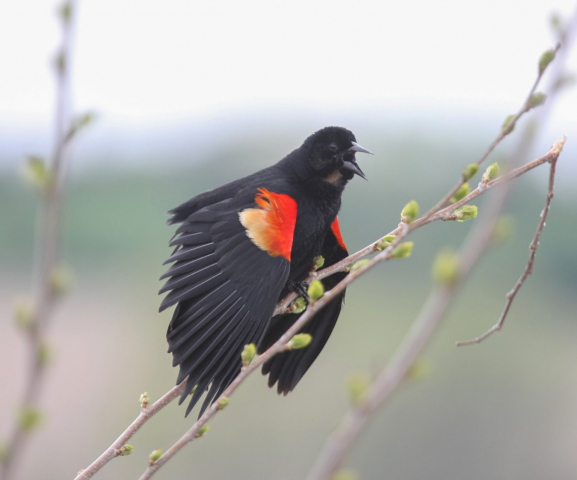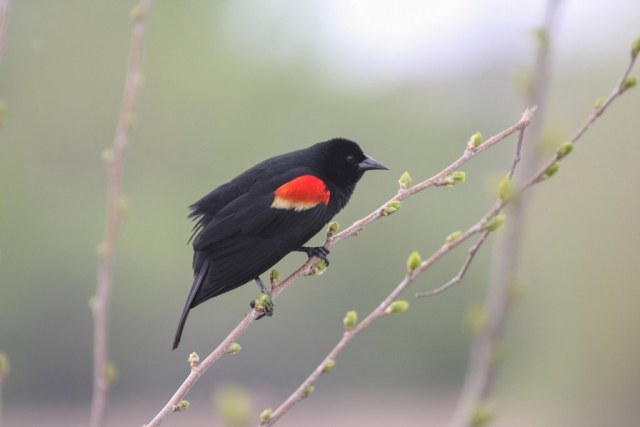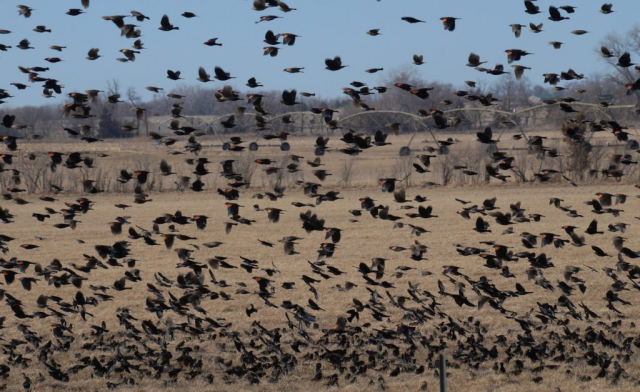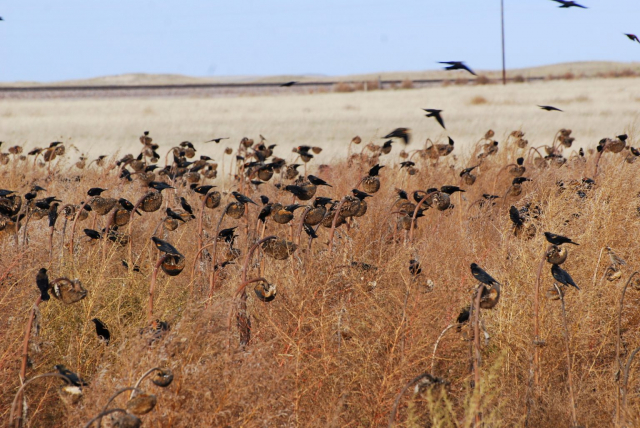Agelaius phoeniceus phoeniceus, A. p. fortis, A. p. arctolegus
Status: Abundant regular spring and fall migrant statewide. Common, locally abundant breeder statewide. Fairly common regular winter visitor south and east, uncommon west, rare north.
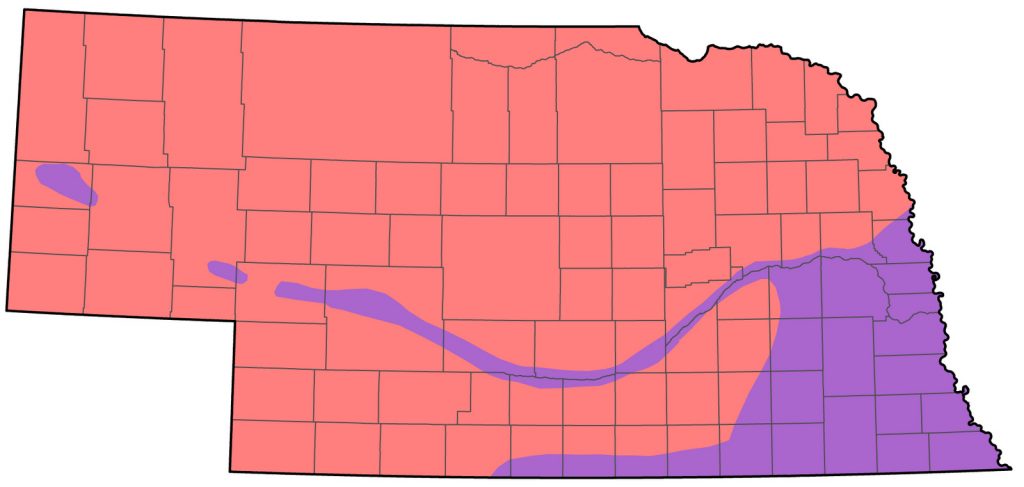
Documentation: Specimens: phoeniceus, UNSM ZM6993, 11 May 1914 Lincoln, Lancaster Co; fortis, UNSM ZM6987, 1 Jul 1916 Scotts Bluff Co; arctolegus, UNSM ZM6999, 28 Apr 1895 Lancaster Co.
Taxonomy: Twenty-two subspecies are recognized (Yasukawa and Searcy 2020, AviList 2025); ranges suggest occurrence of three in Nebraska: arctolegus breeding from southeastern Alaska and Yukon to north-central US, wintering to south-central US, fortis breeding from Montana to southeastern New Mexico (east of Rocky Mountains), wintering to Texas, and phoeniceus breeding from southeastern Canada to Texas and the southeastern US, wintering southward to Gulf Coast.
While we concur in general with Jaramillo and Burke (1999) that most breeding birds in Nebraska are probably intergrades, two subspecies have been documented in Nebraska within the breeding season: fortis and phoeniceus. According to AOU (1957), the Great Plains subspecies fortis breeds in western Nebraska, eastern phoeniceus breeds in southeastern Nebraska and most of Kansas. The eastward extent of the breeding range of fortis was shown in Harris (1919) and suggested by a specimen collected in Clay Co 8 May 1918 (UNSM ZM6972); another Clay Co specimen, collected 18 May 1920 (UNSM ZM6992), however, was identified as phoeniceus. Harris (1919) showed the breeding range of predatorius (=phoeniceus) to be limited to southeastern Nebraska. Subspecies arctolegus breeds south to southern South Dakota and possibly extreme northern Nebraska but has not been reported during the breeding season in Nebraska.
Most summering birds probably do not overwinter in the state; Ohio data (Bent 1968) showed that breeding birds (phoeniceus) were replaced in winter by northern birds (arctolegus). Nebraska banding data indicate that breeding birds from North and South Dakota (presumably arctolegus) pass through eastern Nebraska during migration, while birds breeding in or migrating through the Panhandle (presumably fortis) winter a short distance to the south in Colorado or on occasion in Nebraska. The 28 Apr specimen cited above for arctolegus (UNSM ZM6999) was probably a late migrant; the only other UNSM specimen of arctolegus, collected in Lancaster Co 10 Oct 1889 (UNSM ZM6998), was more definitely a migrant. Banding data also indicate that some Nebraska migrants come from states to the northwest, including Wyoming and Montana; these birds are probably fortis.
The type specimen of fortis was collected at Omaha, Douglas Co 9 Mar (Bruner et al 1904); this form is a regular migrant as far east as western Iowa (DuMont 1934).
Spring: Migration patterns of this species by age and sex class were discussed by Yasukawa and Searcy (2020) and Dolbeer (1978, 1982).
Males appear first in spring, arriving in late Feb and early Mar. Early males were on territory in the Sandhills 8 Feb 1998, in Scotts Bluff Co 12 Feb 2016, and at North Platte, Lincoln Co 13 Feb 2014. There may be two weeks between arrival of territorial males and females. A “general arrival” of females was noted in Cass and Sarpy Cos 29 Mar 2006, a flock of 80 females was near Talmage, Otoe Co 28 Apr 2013, a flock of 300 females in Burt Co 30 Apr 2021, a flock of 75 females was at Oliver Reservoir, Kimball Co 1 May 2004, and flock of about 1000 females was in the eastern Rainwater Basin as late as 4 May 1997. A flock of immature males was seen in southeast Nebraska 13 Mar 2005, when no females were noted in the area and adult males were on territory. In Holt Co in 1990 the first birds seen were 26 Feb, with flocks noted 11 Mar (Blake and Ducey 1991), and in the north-central, males were on territory by 4 Apr in 1982, but females were not seen until 14 Apr (Brogie and Mossman 1983).
- High counts: 100,000 at Jack Sinn WMA, Lancaster Co 5 Apr 2014, 75,000 in Lincoln Co 15 Feb 2015, 60,000 near Elwood, Dawson Co 26 Mar 2024, 38,000 in Scotts Bluff Co 6 Mar 1994, 35,000 at Kiowa WMA, Scotts Bluff Co 8 Mar 1998, and 35,000 at Golden Spike Tower, Lincoln Co 19 Mar 2025.
Summer: This species is ubiquitous, perhaps with lowest densities in the Panhandle, as indicated by BBS data, although Mollhoff (2016) depicted even distribution statewide. Largest numbers nest at the margins of permanent marshes statewide, usually over shallower water than Yellow-headed Blackbird where the two occur together. However large numbers also have adapted to upland habitats, notably irrigated alfalfa fields in the west. BBS trend analysis (Sauer et al 2020) shows an annual change of -0.41% (95% C.I.; -0.94, 0.11) statewide 1966-2019, indicating numbers have remained relatively stable during the period.
William Flack (personal communication) provided an interesting discussion regarding male involvement in chick-rearing; the trade-off for males appears to be increased numbers of young fledged with male involvement versus increased numbers of female mates without. Flack’s observations indicated there might be clinal variation in male involvement across the state, but the sample size is too small to be conclusive.
- Breeding phenology:
Nest-building: 23 Apr-21 Jul
Eggs: 10 Apr-8 Jul (Mollhoff 2022)
Nestlings: 10 May- 30 Jul
Fledglings: 27 May-30 Jul
- High counts: 800 near Agate, Sioux Co 20 Jun 2022, 500 at Lake McConaughy, Keith Co 4 Jun 2007, and 500 at Mallard Haven WPA, Fillmore Co 2 Jun 2021.
Fall: Flocks form in Jul, composed of young birds and females; these flocks are joined later by males. Best counts in mid-Jul are 2200 at Jack Sinn WMA, in Saunders Co 18 Jul 2015, 600 at Ta-Ha-Zouka Park, Madison Co 6 Jul 2010, and 600 at Wood Duck WMA, Stanton Co 18 Jul 2020. A flock of 50 females was near Lincoln, Lancaster Co 3 Nov, suggesting that it may be rather late in fall before mixed-gender flocks form. “Several thousand” were in Buffalo Co 19 Jul 1997 and 4000 at Funk WPA, Phelps Co 8 Aug 1998.
Red-winged Blackbirds are inconspicuous during Aug, when molting takes place in marsh vegetation. Flocks reappear in Sep, such as the 25,000 over Seward Co in three groups of 5000-15,000 3 Sep 2023, and migration takes place in Oct and Nov (Bent 1968). By late Dec most have left the state, although an impressive 60,000 were at Kiowa WMA, Scotts Bluff Co 18 Dec 2022. Large roosts may still be present during the CBC period in the south and east: 500,000 were at North Platte in 1977, 255,806 were at Omaha in 1984, and 187,065 were there in 1987. Flocks of this size have not been recorded in Jan.
- High counts: 100,000 at Clear Creek Marshes, Garden Co 27 Oct 1996, 45,027 in Lincoln Co 27 Oct 2014, 18,000 at Lakes North and Babcock, Platte Co 30 Oct 2022, and 17,500 in Lincoln Co 9 Nov 2015.
Winter: Relatively few overwinter, with much variability in numbers during and between winters. Flocks remain at favored locations into mid-winter if food and shelter is available (Rosche 1982, 1994), although overwintering flocks are relatively small, such as 2000 in Scotts Bluff Co 25 Jan 2007, 2200 at Branched Oak Lake, Lancaster Co during winter 2013-2014, and 1500 in Lancaster Co 1 Feb 2013. Large flocks rarely remain past mid-Jan, such as the 25,000 in the Brady-Maxwell area in Lincoln Co Dec 2015-Jan 2016. Large flocks of 20,706 at Clear Creek Marshes 29 Jan 2000, 15,000 along Highway 92 near Lewellen in Garden Co 30 Jan 2024, and 12,500 in a sheltered creek bottom in Pawnee Co 8 Feb 1997 may have been early migrants.
Northerly mid-winter (mid-late Jan) sightings are usually of single males, however, three females in Scotts Bluff Co 9 Jan 2011 were unexpected, as were a female in Dakota Co 11 Jan 2009 and a mixed-gender flock of 110 there 14 Jan 2020, two birds at Valentine NWR, Cherry Co 18 Jan 2020, 18 at Seneca, Thomas Co 21 Jan 2024, five at Thedford, Thomas Co 22 Jan 2024, two in Grant Co 26 Jan 2012, and a female-only flock of 250 in Scotts Bluff Co 19 Jan 2013.
This species was unusually numerous in mid-late Jan 2023 in the northeast, notably including a large flock of 700 in Dakota Co 20 Jan, as well as reports of up to 50 (on 29 Jan) near Wakefield, Dixon Co 10-29 Jan, four in Wayne, Wayne Co 22 Jan, and 21 at Buckskin Hills WMA, Dixon Co 24 Jan.
Images
Abbreviations
BBS: Breeding Bird Survey
CBC: Christmas Bird Count
NWR: National Wildlife Refuge
UNSM: University of Nebraska State Museum
WMA: Wildlife Management Area (State)
WPA: Waterfowl Production Area (Federal)
Acknowledgement
This species account was improved through discussions with Jon King regarding taxonomy of this species.
Literature Cited
American Ornithologists’ Union [AOU]. 1957. The AOU Check-list of North American birds, 5th ed. Port City Press, Baltimore, Maryland, USA.
AviList Core Team, 2025. AviList: The Global Avian Checklist, v2025. https://doi.org/10.2173/avilist.v2025.
Bent, A.C. 1968. Life histories of North American Cardinals, Grosbeaks, Buntings, Towhees, Finches, Sparrows, and allies. Bulletin of the United States National Museum 237. Three Parts. Dover Publications Reprint 1968, New York, New York, USA.
Blake, L., and J. E. Ducey. 1991. Birds of the eastern Sandhills in Holt County, Nebraska. NBR 59: 103-132.
Brogie, M.A., and M.J. Mossman. 1983. Spring and summer birds of the Niobrara Valley Preserve, Nebraska: An annotated checklist. NBR 51: 44-51.
Bruner, L., R.H. Wolcott, and M.H. Swenk. 1904. A preliminary review of the birds of Nebraska, with synopses. Klopp and Bartlett, Omaha, Nebraska, USA.
Dolbeer, R.A. 1978. Movement and migration patterns of Red-winged Blackbirds: a continental perspective. Bird Banding 49: 17-34.
Dolbeer, R.A. 1982. Migration patterns for age and sex classes of blackbirds and starlings. Journal of Field Ornithology 53: 28-46.
DuMont, P.A. 1934. A revised list of the birds of Iowa. University of Iowa Studies. Studies in Natural History 15 (5).
Harris, H. 1919. Birds of the Kansas City Region. Transactions of the Academy of Science of St. Louis. 23, no. 8.
Jaramillo, A., and P. Burke. 1999. New World Blackbirds- The Icterids. Princeton University Press, Princeton, New Jersey, USA.
Mollhoff, W.J. 2016. The Second Nebraska Breeding Bird Atlas. Bull. Univ. Nebraska State Museum Vol 29. University of Nebraska State Museum, Lincoln, Nebraska, USA.
Mollhoff, W.J. 2022. Nest records of Nebraska birds. Nebraska Ornithologists’ Union Occasional Paper Number 9.
Rosche, R.C. 1982. Birds of northwestern Nebraska and southwestern South Dakota, an annotated checklist. Cottonwood Press, Crawford, Nebraska, USA.
Rosche, R.C. 1994. Birds of the Lake McConaughy area and the North Platte River valley, Nebraska. Published by the author, Chadron, Nebraska, USA.
Sauer, J.R., W.A. Link and J.E. Hines. 2020. The North American Breeding Bird Survey – Analysis Results 1966-2019. U.S. Geological Survey data release, https://doi.org/10.5066/P96A7675, accessed 27 Jul 2023.
Yasukawa, K. and W.A. Searcy. 2020. Red-winged Blackbird (Agelaius phoeniceus), version 1.0. In Birds of the World (P. G. Rodewald, Editor). Cornell Lab of Ornithology, Ithaca, NY, USA. https://doi.org/10.2173/bow.rewbla.01.
Recommended Citation
Silcock, W.R., and J.G. Jorgensen. 2025. Red-winged Blackbird (Agelaius phoeniceus). In Birds of Nebraska — Online. www.BirdsofNebraska.org
Birds of Nebraska – Online
Updated 31 Aug 2025
